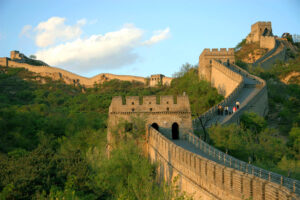
In celebration of the Chinese New Year, which started being celebrated on the 10th of February, this week’s article is delving into the historical relationships between the Netherlands and China.
The close ties between the Chinese and Dutch people have been forged over centuries, primarily through the historic Silk Road. The enduring friendship between China and the Netherlands has weathered the trials of time. Dutch-Chinese relations trace back to the sixteenth century, marked by the maritime exploits of Dirck Gerritszoon Pomp from Enkhuizen, who embarked on voyages to Chinese and other Far Eastern ports aboard a Portuguese vessel. His journeys were meticulously documented by Lucas Janszoon Waghenaer in his work “Thresoor der Zeevaert” (“treasure of Shipping”), capturing the attention of the Gentlemen XVII, the governing body of the Dutch East Indies Company. They sought to establish direct trade with China as a natural extension of their existing trade routes to the Indonesian archipelago. In 1601 and 1603, Dutch East Indies Company representatives ventured to the Chinese coast in hopes of fostering trade relations, albeit with limited success. A significant milestone occurred in 1655 when the first Dutch mission set out for Peking, aiming to secure permission for regular trade. Despite subsequent unsuccessful attempts, a breakthrough came in 1686 when a Dutch delegation in Peking successfully negotiated trading privileges, allowing Dutch vessels to visit Chinese ports every five years. Over time, trade relations between the two nations gradually flourished.
While discussing Dutch-Chinese relations, a short history of the Sino-Dutch treaty system should of course be mentioned. Imperialism in China became institutionalized through a complex network of agreements and privileges outlined in a series of bilateral and multilateral treaties between the Qing Empire and Western powers during the latter half of the 19th century. These treaties typically focused on specific areas such as foreign trade and residency, customs regulations, property protection, jurisdictional matters, navigation rights, and the presence of foreign ships and missionaries. While the fragmented nature of this system, involving 19 treaty powers with competing interests, distinguished it from more unified imperial structures elsewhere, Chinese imperialism still rested on a formal framework of treaty rights that needed to be legally annulled for China to achieve its desired “national emancipation.”
The legal foundation for Dutch involvement in this system stemmed from the 1863 Sino-Dutch Treaty of Tianjin, modelled after similar treaties imposed on the Qing Empire by Britain, the United States, and France following the Second Opium War. Article 15 of this treaty included a most-favoured-nation clause, granting the Dutch automatic access to concessions granted by China to other powers and thereby limiting the treaty’s scope to issues requiring explicit legal stipulations. One such issue was extraterritoriality, a unilateral privilege that allowed foreign consular courts exclusive jurisdiction over legal matters involving foreign citizens in China’s treaty ports, effectively exempting them from Chinese laws. By enacting relevant statutes in 1871, the Dutch established consular courts in several of China’s treaty ports to handle legal cases involving Dutch nationals. Utilizing the most-favoured-nation clause, the Dutch also participated in appointing consular officers as observers and, in practice, co-judges in Chinese courts. Additionally, the Dutch played an active role in governing the international settlements in Shanghai and Xiamen through direct representation on executive municipal councils and supervisory consular bodies.
In 1880, the Dutch established a legation in Peking, solidifying ongoing diplomatic ties. Even after the upheavals of the 1949 Revolution, the Netherlands maintained consistent relations with China, formally recognizing the People’s Republic of China in 1950. Another significant treaty in the Sino-Dutch relationship was the Boxer Protocol of 1901. Despite not being part of the Eight-Nation Alliance that quelled the Boxer Rebellion, the Netherlands participated in subsequent peace negotiations to seek compensation for damages to the Dutch legation and the precautionary deployment of three Dutch warships. In addition to granting the Dutch a share of China’s substantial war reparations, the Boxer Protocol facilitated Dutch involvement in jointly administering the legation quarter in Beijing, expanding the Dutch diplomatic compound, and establishing a permanent legation guard, which operated until 1923.
The ties between the Netherlands and China go beyond the short history mentioned in this week’s article, however, the following article will delve into the current Dutch-Chinese relations and migration between the two countries as well as the communities formed in both countries.
References
Chang, V. (2021). Allies as adversaries: China, the Netherlands and clashing nationalisms in the emergence of the post-war order, 1942–1945. Nations and Nationalism, Vol. 27, DOI: 10.1111/, 1253–1267.
Kroese , C. (1965). Dutch Trade with the People’s Republic of China.
Photo:

